Toolbars seem to be a theme this week... :)
So you basically have the right idea but the tricky part is figuring out the required size. Unfortunately the QToolBar layout is completely private so we have to figure stuff out on our own (even though it inherits from QLayout you can't get an instance of it via QToolBar::layout()).
This implementation is fairly basic and will probably not handle all cases (I only tested with basic actions, no custom widgets or such), but it does work for that (tested on Windows and Linux with various styles).
ADDED: I realize you weren't asking for a QToolBar specifically, but that's what you essentially described... I'm not sure why re-invent that wheel (a QToolBar can be placed in any layout, doesn't have to be in a main window), but if you were to implement your own version I think a lot of this example would still apply. I would also personally almost always use QActions for triggering UI events (vs. buttons) since they can be assigned to any number of UI elements (toolbar, manu bar, context menu, window shortcuts, etc.).
Adding a margin/hysteresis is left as an exercise for the reader... :) I don't think it needs one, but you could pad m_expandedSize in initSizes() with some arbitrary margin.
CollapsingToolBar
#include <QtWidgets>
class CollapsingToolBar : public QToolBar
{
Q_OBJECT
public:
explicit CollapsingToolBar(QWidget *parent = nullptr) : CollapsingToolBar(QString(), parent) {}
explicit CollapsingToolBar(const QString &title, QWidget *parent = nullptr) :
QToolBar(title, parent)
{
initSizes();
// If icon sizes change we need to recalculate all the size hints, but we need to wait until the buttons have adjusted themselves, so we queue the update.
connect(this, &QToolBar::iconSizeChanged, [this](const QSize &) {
QMetaObject::invokeMethod(this, "recalcExpandedSize", Qt::QueuedConnection);
});
// The drag handle can mess up our sizing, update preferred size if it changes.
connect(this, &QToolBar::movableChanged, [this](bool movable) {
const int handleSz = style()->pixelMetric(QStyle::PM_ToolBarHandleExtent, nullptr, this);;
m_expandedSize = (movable ? m_expandedSize + handleSz : m_expandedSize - handleSz);
adjustForSize();
});
}
protected:
// Monitor action events to keep track of required size.
void actionEvent(QActionEvent *e) override
{
QToolBar::actionEvent(e);
int width = 0;
switch (e->type())
{
case QEvent::ActionAdded:
// Personal pet-peeve... optionally set buttons with menus to have instant popups instead of splits with the main button doing nothing.
//if (QToolButton *tb = qobject_cast<QToolButton *>(widgetForAction(e->action())))
// tb->setPopupMode(QToolButton::InstantPopup);
//Q_FALLTHROUGH;
case QEvent::ActionChanged:
width = widthForAction(e->action());
if (width <= 0)
return;
if (e->type() == QEvent::ActionAdded || !m_actionWidths.contains(e->action()))
m_expandedSize += width + m_spacing;
else
m_expandedSize = m_expandedSize - m_actionWidths.value(e->action()) + width;
m_actionWidths.insert(e->action(), width);
break;
case QEvent::ActionRemoved:
if (!m_actionWidths.contains(e->action()))
break;
width = m_actionWidths.value(e->action());
m_expandedSize -= width + m_spacing;
m_actionWidths.remove(e->action());
break;
default:
return;
}
adjustForSize();
}
bool event(QEvent *e) override
{
// Watch for style change
if (e->type() == QEvent::StyleChange)
recalcExpandedSize();
return QToolBar::event(e);
}
void resizeEvent(QResizeEvent *e) override
{
adjustForSize();
QToolBar::resizeEvent(e);
}
private slots:
// Here we do the actual switching of tool button style based on available width.
void adjustForSize()
{
int availableWidth = contentsRect().width();
if (!isVisible() || m_expandedSize <= 0 || availableWidth <= 0)
return;
switch (toolButtonStyle()) {
case Qt::ToolButtonIconOnly:
if (availableWidth > m_expandedSize)
setToolButtonStyle(Qt::ToolButtonTextBesideIcon);
break;
case Qt::ToolButtonTextBesideIcon:
if (availableWidth <= m_expandedSize)
setToolButtonStyle(Qt::ToolButtonIconOnly);
break;
default:
break;
}
}
// Loops over all previously-added actions and re-calculates new size (eg. after icon size change)
void recalcExpandedSize()
{
if (m_actionWidths.isEmpty())
return;
initSizes();
int width = 0;
QHash<QAction *, int>::iterator it = m_actionWidths.begin();
for ( ; it != m_actionWidths.end(); ++it) {
width = widthForAction(it.key());
if (width <= 0)
continue;
m_expandedSize += width + m_spacing;
it.value() = width;
}
adjustForSize();
}
private:
void initSizes()
{
// Preload some sizes based on style settings.
// This is the spacing between items
m_spacing = style()->pixelMetric(QStyle::PM_ToolBarItemSpacing, nullptr, this);
// Size of a separator
m_separatorWidth = style()->pixelMetric(QStyle::PM_ToolBarSeparatorExtent, nullptr, this);
// The layout margins (we can't even get the private QToolBarLayout via layout() so we figure it out like it does)
m_expandedSize = (style()->pixelMetric(QStyle::PM_ToolBarItemMargin, nullptr, this) + style()->pixelMetric(QStyle::PM_ToolBarFrameWidth, nullptr, this)) * 2;
// And the size of the drag handle if we have one
if (isMovable())
m_expandedSize += style()->pixelMetric(QStyle::PM_ToolBarHandleExtent, nullptr, this);
}
int widthForAction(QAction *action) const
{
// Try to find how wide the action representation (widget/separator) is.
if (action->isSeparator())
return m_separatorWidth;
if (QToolButton *tb = qobject_cast<QToolButton *>(widgetForAction(action))) {
const Qt::ToolButtonStyle oldStyle = tb->toolButtonStyle();
// force the widest size
tb->setToolButtonStyle(Qt::ToolButtonTextBesideIcon);
const int width = tb->sizeHint().width();
tb->setToolButtonStyle(oldStyle);
return width;
}
if (const QWidget *w = widgetForAction(action))
return w->sizeHint().width();
return 0;
}
int m_expandedSize = -1; // The maximum size we need with all buttons expanded and allowing for margins/etc
int m_spacing = 0; // Layout spacing between items
int m_separatorWidth = 0; // Width of separators
QHash<QAction *, int> m_actionWidths; // Use this to track action additions/removals/changes
};
Test/demo
// An XPM icon ripped from QCommonStyle
static const char * const info_xpm[]={
"32 32 5 1",
". c None",
"c c #000000",
"* c #999999",
"a c #ffffff",
"b c #0000ff",
"...........********.............",
"........***aaaaaaaa***..........",
"......**aaaaaaaaaaaaaa**........",
".....*aaaaaaaaaaaaaaaaaa*.......",
"....*aaaaaaaabbbbaaaaaaaac......",
"...*aaaaaaaabbbbbbaaaaaaaac.....",
"..*aaaaaaaaabbbbbbaaaaaaaaac....",
".*aaaaaaaaaaabbbbaaaaaaaaaaac...",
".*aaaaaaaaaaaaaaaaaaaaaaaaaac*..",
"*aaaaaaaaaaaaaaaaaaaaaaaaaaaac*.",
"*aaaaaaaaaabbbbbbbaaaaaaaaaaac*.",
"*aaaaaaaaaaaabbbbbaaaaaaaaaaac**",
"*aaaaaaaaaaaabbbbbaaaaaaaaaaac**",
"*aaaaaaaaaaaabbbbbaaaaaaaaaaac**",
"*aaaaaaaaaaaabbbbbaaaaaaaaaaac**",
"*aaaaaaaaaaaabbbbbaaaaaaaaaaac**",
".*aaaaaaaaaaabbbbbaaaaaaaaaac***",
".*aaaaaaaaaaabbbbbaaaaaaaaaac***",
"..*aaaaaaaaaabbbbbaaaaaaaaac***.",
"...caaaaaaabbbbbbbbbaaaaaac****.",
"....caaaaaaaaaaaaaaaaaaaac****..",
".....caaaaaaaaaaaaaaaaaac****...",
"......ccaaaaaaaaaaaaaacc****....",
".......*cccaaaaaaaaccc*****.....",
"........***cccaaaac*******......",
"..........****caaac*****........",
".............*caaac**...........",
"...............caac**...........",
"................cac**...........",
".................cc**...........",
"..................***...........",
"...................**..........."};
class MainWindow : public QMainWindow
{
Q_OBJECT
public:
MainWindow(QWidget *parent = nullptr)
: QMainWindow(parent)
{
QToolBar* tb = new CollapsingToolBar(this);
tb->setToolButtonStyle(Qt::ToolButtonTextBesideIcon);
tb->setAllowedAreas(Qt::TopToolBarArea | Qt::BottomToolBarArea);
QIcon icon = QIcon(QPixmap(info_xpm));
for (int i=0; i < 6; ++i)
tb->addAction(icon, QStringLiteral("Action %1").arg(i));
addToolBar(tb);
show();
// Adding another action after show() may collapse all the actions if the new toolbar preferred width doesn't fit the window.
// Only an issue if the toolbar size hint was what determined the window width to begin with.
//tb->addAction(icon, QStringLiteral("Action After"));
// Test setting button style after showing (comment out the one above)
//tb->setToolButtonStyle(Qt::ToolButtonTextBesideIcon);
// Test changing icon size after showing.
//tb->setIconSize(QSize(48, 48));
// Try this too...
//tb->setMovable(false);
}
};
int main(int argc, char *argv[])
{
QApplication app(argc, argv);
//QApplication::setStyle("Fusion");
//QApplication::setStyle("windows");
MainWindow w;
return app.exec();
}





